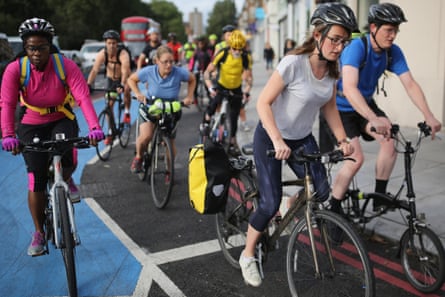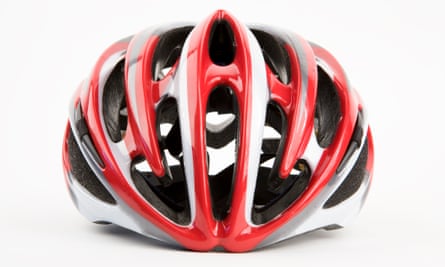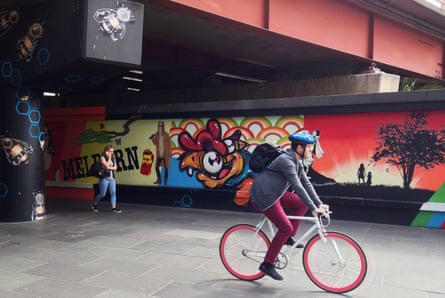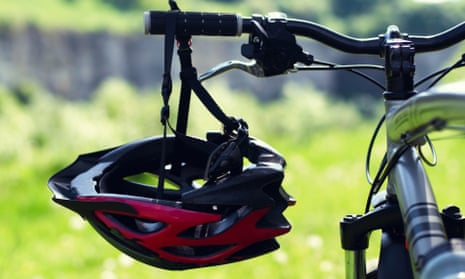As a cyclist, I don’t object to helmets or to high-visibility clothing. Like the majority of people I know in London, I wear a helmet most of the time when on a bike. I do, however, have serious worries about efforts to make the use of hi-vis clothes or helmets compulsory, or even to encourage them as a safety panacea. Because when it comes to genuine efforts to make cycling safer, they are a red herring, an irrelevance, a peripheral issue that has somehow come to dominate the argument.
Olympic cycling champion Chris Boardman eloquently expressed this when an appearance on BBC1’s Breakfast show to discuss bike infrastructure became dominated by angry viewer reactions to him being filmed cycling down a street bare-headed. “I understand exactly why people feel so passionately about helmets or hi-vis,” Boardman wrote. “I understand why people wish to use them. But these actions seek to deal with an effect. I want to focus the debate on the cause, and campaign for things that will really make cycling safe. That is why I won’t promote high-vis and helmets – I won’t let the debate be drawn on to a topic that isn’t even in the top 10 things that will really keep people who want to cycle safe.”
Boardman is not alone in finding that helmet use provokes strong and strange reactions. Nick Hussey, the founder of a British cycle clothing company, Vulpine, became so perturbed by the vicious social media reaction when his firm’s website featured models on bikes without helmets that he wrote a response for the Guardian’s cycling blog. It began with the parallel of him hypothetically marching into a bar and snatching a third or fourth pint of beer from a random drinker’s lips, yelling, “Stop drinking or you will die!”
“That’s more or less what the infamous helmet debate has become,” Hussey lamented. “Shouty strangers shouting at other shouty strangers for choices that don’t affect the first shouty stranger’s life. It’s a bit weird, definitely a waste of energy, and not a fun place for cyclists to share space in.”
As Boardman noted, in the Netherlands, perhaps the least perilous country for cyclists in the world, helmets and hi-vis are almost unknown. You don’t make cycling safe by obliging every rider to dress up as if for urban warfare. You do it by creating a road system that insulates them from fast-moving and unpredictable road traffic.

In contrast, the great majority of UK cyclists ride helmeted, something which saw bike helmets added back into the official “basket” of goods used to measure the inflation rate in March.
Dr John Black is an eminent doctor of emergency medicine who has managed helicopter acute medical teams and advised the government on emergency care. He has seen the terrible consequences that can follow from a head injury on a bike, something the evidence shows can be worsened if the rider is not wearing a helmet. Black believes helmets should be obligatory by law. He was among a series of doctors who wrote to the British Medical Association requesting that it formally call for mandatory helmet use. It subsequently did, a decision that remains controversial.
Black sees his views as “simple common sense”. “If someone’s unprotected head strikes a solid surface such as the roadside or the pavement, even if it’s a ground-level fall, patients can sustain devastating head and brain injuries,” he says. “We know that the wearing of cycling helmets can reduce the risk of that by up to two-thirds.” Black says he has treated young people who suffered injuries that left them unable to live independently. “I just don’t think we can afford to plan for, particularly, young people of working age potentially being incapacitated and needing lifelong care, with all the devastating consequences that has, not just for them but for their families,” he says. “I don’t think we can afford to be complacent about this issue.”
All this makes perfect sense, does it not? Let’s hear, however, from another doctor. Dr Harry Rutter is a public health expert who specialises in physical activity. He is sceptical about an excessive focus on helmets as a safety measure. “Most of the risk of severe injury while cycling is not intrinsic to the activity – motorists impose it on cyclists,” he argued in the influential handbook City Cycling. “Cycling is a benign activity that often takes place in dangerous environments. Of the three main elements determining serious cycling injuries – the road design and conditions, the motorist and the cyclist – the cyclist is the most studied.”

If I want an expert on one patient’s head trauma, then Black is the doctor I would choose. But Rutter is an epidemiologist, and so looks at issues on a population-wide level. And the problem with the helmet debate is that too few people do this.
But let’s begin with something hopefully straightforward and more individual: if you happened to fall off your bike and strike your head, a well-fitted and properly fastened helmet would offer some injury protection. A major 2001 review of the research concluded that helmets reduce the risk of head injury by 60%. A 2011 examination of this study by Rune Elvik, a Norwegian academic and road safety expert, said the overall protection could be slightly reduced given what seems to be an increase in the likelihood of a neck injury if you wear a helmet (another source of endless debate).
Now, however, things begin to get more complicated. In his analysis, Elvik noted that whatever the benefits in each individual case, a population-wide increase in helmet use, for example after legislation, is not generally matched by similar reductions in overall head injury rates. Again, with helmets things are never as straightforward as they appear.
Robert Chirinko is a man with a minor obsession for spotting how people’s behaviour changes according to their perception of risk. Thus, he notes, while a small car might be less safe if someone is actually in a crash, recognition of this fact often makes a person more likely to drive carefully, and they may well end up safer overall.
He also has thoughts on the plague of serious concussions affecting American football. “Is the solution more padded helmets and other protections? Offsetting behaviour suggests that more protections lead to a greater feeling of safety, and hence an increase in the severity of tackles, blocks and other confrontations,” he says. “It follows that the solution may well be less protection. If US footballers feel less safe, they will surely temper their performance on the field accordingly, with desirable health outcomes for all participants.”

Chirinko is an economist at the University of Illinois at Chicago, not a doctor or road safety expert. But his ideas about offsetting behaviour – his profession’s term for what psychologists call risk compensation – is a fascinating element to the discussion over bike helmets. Crucially, it seems the perception of reduced risk when a helmet is worn can both prompt riders to be more reckless with their own safety and nudge drivers into being less careful towards cyclists.
One of the most famous experiments connected to risk perception and cycle helmets was carried out by Dr Ian Walker, a psychologist at the University of Bath. Walker is a man who has researched attitudes and reactions to cyclists with more thoroughness than most. In 2006 he attached a computer and an electronic distance gauge to his bike and recorded data from 2,500 drivers who overtook him on the roads. Half the time he wore a bike helmet and half the time he was bare-headed. The results showed motorists tended to pass him more closely when he had the helmet on, coming an average of 8.5 cm nearer. Walker said he believed this was likely to be connected to cycling being relatively rare in the UK, and drivers thus forming preconceived ideas about cyclists based on what they wore. “This may lead drivers to believe cyclists with helmets are more serious, experienced and predictable than those without,” he wrote.
In a parallel experiment Walker also spent some time riding about wearing a long brunette wig, to see whether drivers gave female cyclists more room than men, perhaps because they also unconsciously assumed women are less experienced cyclists. They did, it emerged, even when the “woman” was 6ft tall and, for the drivers who happened to look in their rear-view mirror, surprisingly hairy.
The converse to all this is yet another study carried out by Walker, this time in 2016, which appeared to show that helmet use could potentially make cyclists themselves act in a more reckless fashion. His experiment saw participants of various ages and both genders asked to play a computer game in which they pressed a button to inflate a balloon on the screen. Each inflation earned them more hypothetical money, but also increased the random chance of the balloon bursting, which would wipe out the winnings. At any point players could stop and bank what they had earned from each individual balloon.
Those taking part were fitted with eye-tracking sensors and told this was the purpose of the experiment. However, the sensors were not plugged in – the real test was that half the participants had the eye tracker fitted to a baseball cap, the other half to a bike helmet. Over dozens of games, those wearing the helmets consistently took greater risks on average when inflating the screen balloons. “The helmet could make zero difference to the outcome, but people wearing one seemed to take more risks in what was essentially a gambling task,” he wrote. “The practical implication of our findings might be to suggest more extreme unintended consequences of safety equipment in hazardous situations than has previously been thought.”

Yes, a helmet might make you safer if you get knocked off. However, it might also, even marginally, increase the chance that this happens in the first place. And it’s when a government decides it needs to pass a law making helmet-wearing compulsory that we start to see even more unintended consequences.
City-wide bike-share schemes have become increasingly common in recent years, spreading to hundreds of places around the world. These have almost invariably proved hugely popular. Not, however, in Australia. If you ride a share bike in London or New York or Paris or Hangzhou, you can bring a helmet if you want, or otherwise just leap on and pedal away. Do the latter in Melbourne or Brisbane and you risk being stopped and fined by police, because of compulsory helmet-use laws in force since the early 1990s. Both schemes have tried to get around this by placing complimentary helmets on the bikes – Melbourne leaves 1,000 new ones a month – or selling cheap helmets at nearby shops.
But for many people it’s simply too much bother. This is one of the many accidental effects of helmet compulsion. Even in a youthful, vibrant and otherwise innovative city like Melbourne, a bike-share scheme is a non-starter. A small if significant opportunity for creating a human-friendly city – with all the public health benefits that go with it – is lost.
Clover Moore, the mayor of Sydney, says she would also love to create a bike-share system there but feels unable to, given the long-standing helmet compulsion law. This comes from the government of the surrounding state, New South Wales, over which she has no control. “I’d like to do it, but with the helmet law it’s not viable,” Moore says. “Australia has a reputation for being a free and easy nation. And the very opposite is true. Australians love rules and regulations, or at least our governments do.”

At some point during a discussion on the subject, a proponent of helmet compulsion will usually say something along the lines of: “Forget all this talk about freedom or inconvenience. If a bike helmet law saves just one life, then it will be worth it, surely?” This is emotive stuff. But the accidental effects of bike helmet laws can go much further than just undermining bike-share systems. Strange as it may initially sound, there is evidence that they can end up causing more deaths than they save.
This is down to the apparent deterrent effect helmet laws have on cycling. Some studies have indicated that they put off enough people from riding bikes in the first place that the resulting negative effect on public health more than cancels out any benefits from fewer head injuries. As with everything connected to this subject, it’s worth noting that it’s all bitterly disputed by opposing sides. But the evidence seems solid.
One study carried out for New South Wales transport authorities in 1993, a year after mandatory helmet use for adults in the state was extended to children, was mainly intended to check whether the new law was increasing helmet uptake. This it had, but the researchers also found a 30% reduction in the number of children riding to school. Similar data showed even bigger reductions in bike use in other parts of Australia when helmet laws came in. In New Zealand, where helmet compulsion was introduced in 1994, the number of overall bike trips fell 51% between 1989–90 and 2003–6, according to one research paper. The reasons are mixed. It can be in part because some people simply don’t want to bother with a helmet, a factor arguably less important now than 20-plus years ago, when bike helmets were more expensive and not nearly as comfortable. More pressing, however, appears to be the fact that obligatory helmet use reinforces the notion that cycling isn’t an everyday way to get about, but a specialist pursuit needing safety equipment, which makes it less appealing.
Professor Chris Rissel, a public health expert at the University of Sydney, carried out a 2011 study that asked people in the Australian city about the effect of the helmet-use law. Almost a quarter of respondents said they would cycle more if they did not have to always think about a helmet, with the greatest increase in bike use among younger or occasional cyclists. A repeal of the law would, Rissel said, have a significant positive impact on improved public health. Another Australian academic once tried to quantify this effect.
Piet de Jong, a professor of actuarial science at Macquarie University, crunched figures for the estimated reduction in bike use if helmets are made compulsory against any fall in head injuries. “For most countries, under assumptions favourable to the helmet legislation case, the unintended health costs cancel out the direct health benefit,” he found. For the UK, de Jong calculated that an overall net cost to public health of a helmet law would be about £500m a year. Critics have questioned some of De Jong’s calculations. However, there are other potential health drawbacks to helmet compulsion. For a start, if a law does mean fewer cyclists, you have the possibility of a reverse “safety in numbers” effect – fewer riders on the road could place those remaining at more individual risk.
The only part of the UK to have introduced a cycle helmet law is Jersey. In 2014 the States of Jersey, the island’s centuries-old combined legislature and executive, passed a law compelling children aged 13 or under to wear a helmet, at pains of a £50 fine for their parents.

In many ways, wearing a helmet makes even more sense for children than it does adults. They have a greater likelihood of falling off bikes and, when they do, are more likely to hurt their heads, in part because young bodies are disproportionately weighted towards the skull. My son wears a helmet whenever he is cycling. That said, there is no evidence that Jersey’s law will achieve anything at all.
The island’s government commissioned the UK’s respected and independent Transport Research Laboratory to evaluate the plan. Its report found that the year before the ban, 84% of Jersey children wore helmets anyway, and not a single under-14 had been seriously hurt on a bike.
At the time, I spoke to Andrew Green, the Jersey politician behind the law. He dismissed the idea that it would see a reduction in cycling, but offered only an anecdotal view as to why: “I believe children participating in cycling will increase after the law, based on the number of phone calls I’ve had from parents saying, ‘I want little Johnny to wear a helmet. He won’t wear it because his friends won’t wear one. Therefore I won’t let him have a bike.’” It’s an argument. But it’s not evidence.
The tragic backstory to Green’s interest is that his now-adult son is unable to live independently after he suffered a serious head injury on a bike when he was nine. Green himself chairs Headway, a charity that does fantastic work with people who have suffered brain injuries but has branched out, controversially, as a vocal advocate of helmet compulsion.
It’s easy to see why Green does what he does, but equally it’s important that someone counters his views. Of its annual budget of £630m in the year the law was passed, Jersey’s government spent precisely £150,000 on “pedestrian and safety improvements”.
This is a compact island with a benign climate and lots of green space. Yet 23% of its five-year-olds are overweight or obese, rising to 35% of children aged 10 or 11, higher figures than the UK average. When it comes to improving the health of children, the government might be better served doing everything it can to get them on bikes, not creating laws that exaggerate the dangers of doing so.
In 2006 the British Medical Journal carried an examination of the evidence by Dorothy Robinson, an Australian statistician, into what actually happened in New Zealand and Australia after helmet compulsion laws were passed. The study uncovered complications over figures that seem to show a reduction in head injuries suffered by cyclists, a fact much touted by advocates. For example, it found evidence that adult cyclists who opt to wear helmets tend to be more safety-conscious anyway, while helmeted children are more likely than non-helmeted children to ride in parks rather than streets.
Finally, the study noted, helmet-use laws had often come into force at the same time as other road safety measures, such as random driver alcohol breath-testing in parts of Australia, which was likely to have even more impact on safety. The conclusion? The idea that bike helmet laws directly improve overall safety for cyclists doesn’t appear to be backed by any evidence.
In 2013 the tireless Ian Walker carried out a more extensive version of his helmet study. It also measured how closely drivers passed a bike when overtaking, but this time – using a volunteer colleague rather than himself – there were seven different outfits. Four made the rider look like a cyclist of varying experience and dedication, ranging from full Lycra to more everyday clothes, including one involving a hi-vis jacket. Three other outfits were based around bright yellow waistcoats bearing written messages. One read, “Novice cyclist: please pass slowly”; another said, “Polite: please slow down” – “polite” is sometimes used by UK cyclists and horse riders in the hope drivers might mistake it for “police” – and finally one read, “Police: camera cyclist”.
This brought data for just under 5,700 overtakes, more or less evenly split between the seven outfits. None of the outfits made an appreciable difference to driver behaviour, apart from the one saying “police”. For the six others, the average passing distance was between about 114cm and 118cm. For “police” it went above 122cm. Similarly, the proportion of drivers who went very near the bike was noticeably lower for the “police” vest. In contrast, the tabard saying “polite” saw the nearest average overtaking distance and almost twice as many potentially dangerous passes as “police”.
The lessons seem clear and worrying. For one thing, no matter which outfit was worn, a small percentage of drivers still overtook dangerously near, at a distance of 50cm or less. More than this, it seemed drivers were perfectly able to distinguish between different types of rider, and to read and absorb any message displayed. But rather than adjusting their driving to the perceived experience of the cyclist, it was only when faced with a threat to their own welfare – a police rider filming their actions – that many allowed a cyclist more space on the road. Most alarming still, some seemed to treat the mild attempt at deception of “polite” as a reason to almost punish the cyclist.
When Walker carried out his original 2006 helmet experiment, he says, he did not conclude that the results meant drivers didn’t care. “I felt that was a very callous interpretation, and it was more likely that they just took the helmet as an indication of experience,” he says. But the later study changed his view: “It really might have been something like, ‘Well, he’s got a helmet, it doesn’t matter.’”

Comments (…)
Sign in or create your Guardian account to join the discussion